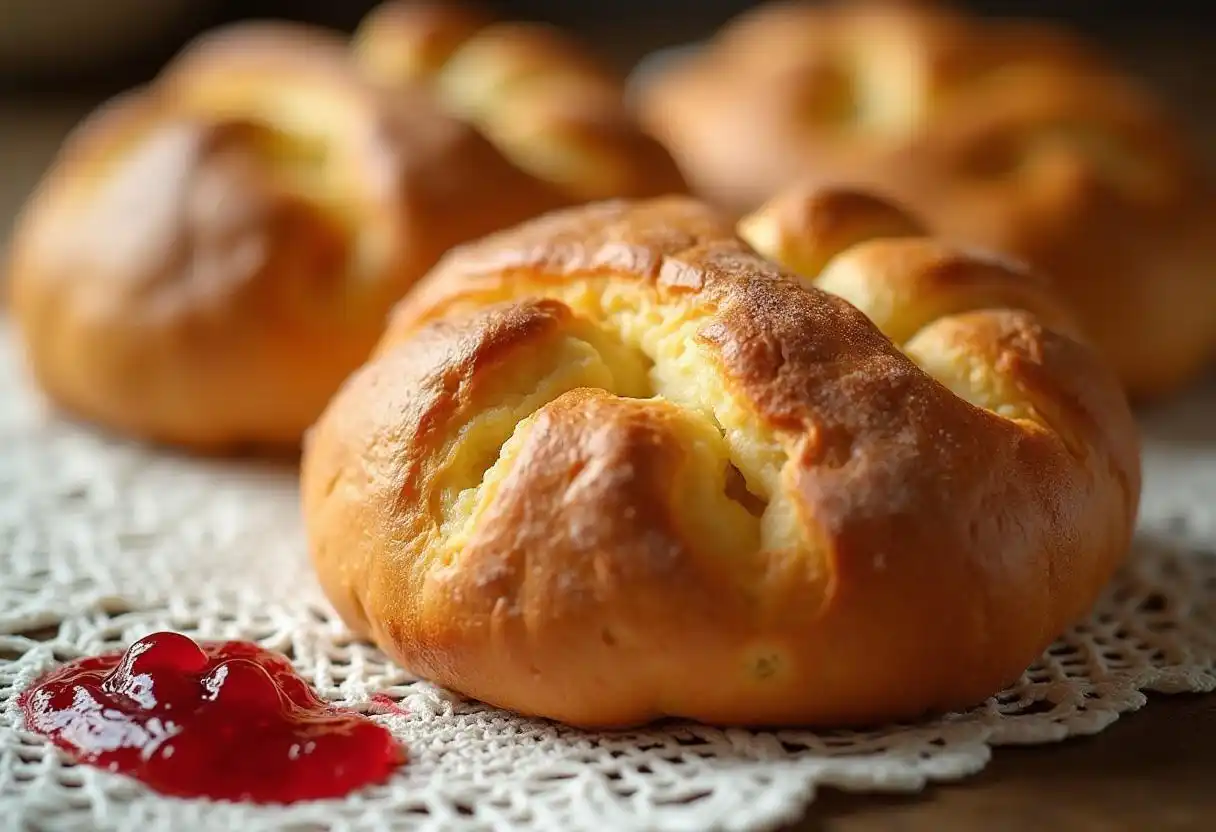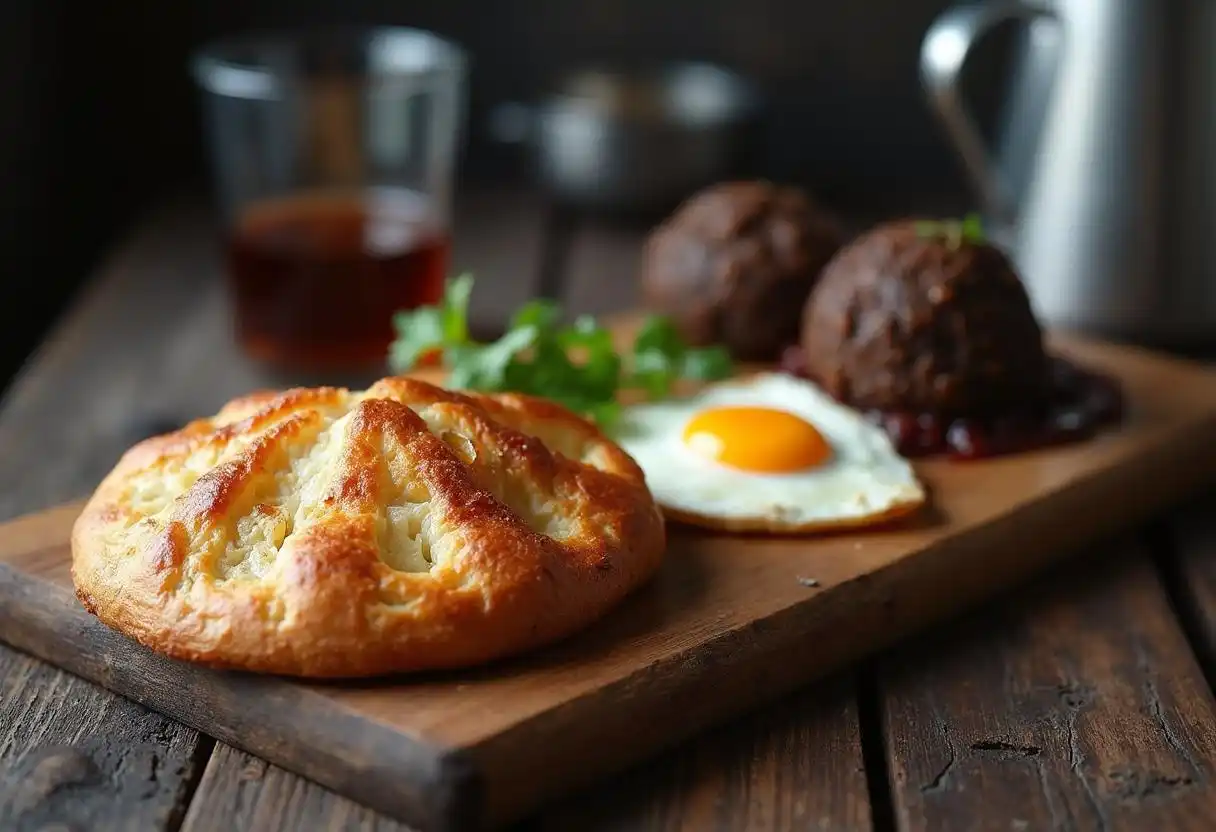Okay, let’s chat pastries! You know how sometimes you just crave that flaky, buttery goodness? Usually, our minds jump straight to croissants – those fancy French crescents you see everywhere. My kids adore them, especially my little chatterbox daughter who’d probably try to “help” eat the whole batch. But the other day, my husband (bless his pun-loving heart) made some joke about kilts and croissants, and it got me thinking… what about other amazing pastries out there? What if I told you Scotland has its own legendary, buttery, flaky delight? Mamma mia, it’s called a “buttery,” or sometimes a “rowie.” So, if you’re wondering, what is the Scottish version of a croissant? Ding ding ding! The buttery is your answer!
These babies might not be strutting down Parisian runways like croissants, but trust me, they’re a huge deal in Scotland, especially up in the northeast. They hold a super special place in Scottish kitchens and hearts. This article is your backstage pass to the world of the buttery. We’ll dig into where they came from, what makes them taste so uniquely delicious (hint: it’s not just butter!), and why they’re such a beloved bite of Scottish culture. Get ready to meet a pastry that’s as cozy, charming, and frankly, a little bit salty (in the best way!) as Scotland itself! We’ll definitely answer the question what is the Scottish version of a croissant? and spill all the tea (or coffee!) on this iconic treat, how it stacks up against a croissant, and what makes it oh-so-special.
Origins and History of the Buttery/Rowie
Alright, gather ’round for story time! The tale of the buttery is as rich and layered as the pastry itself. Its birthplace is way up in the northeast of Scotland, particularly Aberdeenshire. Nope, this isn’t some fancy pastry chef’s invention flown in from afar; it’s a true local hero, born out of necessity. How did it start? Well, Nonna always said the best food comes from humble beginnings, and the buttery is no different. It wasn’t always this flaky, salty dream. Way back when, it was more of a sturdy, bread-like fuel for the hardworking fishermen heading out to sea. Think basic, filling, get-the-job-done kind of food.
But then, magic happened! Over time, bakers started adding lard and butter to that simple dough, folding and layering, transforming it into the glorious, slightly salty, tender buttery we adore today. Isn’t that fantastic? It shows how simple ingredients, a bit of know-how, and probably a lot of love (the most important ingredient, always!) can evolve into a real cultural icon. From fisherman’s fuel to beloved bakery staple, the buttery’s journey is pure Scottish grit and deliciousness. Knowing this history really helps appreciate what is the Scottish version of a croissant – it’s a taste of the past, baked fresh today. It’s a reminder that good food often has deep roots and connects us to the people who came before us.
Cultural Significance of the Buttery
Listen, the buttery isn’t just breakfast – it’s practically woven into the fabric of Scottish life, especially up north! It’s a total staple, showing up proudly on a traditional Scottish breakfast plate right next to the haggis (if you’re brave!), sausages, and eggs. Pop into almost any bakery in Scotland, especially around Aberdeen, and you’ll find stacks of these golden rounds. It’s that perfect grab-and-go bite on a chilly morning or the ideal companion to a strong cuppa tea later in the day. It reminds me a bit of how certain recipes, like maybe a hearty Coronation Chicken, become synonymous with a place and its traditions.
Now, just like my Nonna had her very specific way of making sauce, different parts of Scotland have their own little twists on the buttery. Some like ’em flatter and denser, others prefer them a bit flakier. And you know me, I love seeing traditions evolve! It’s fun to see modern bakeries playing around, maybe adding some sharp cheddar or a sprinkle of herbs. It proves the buttery isn’t some museum piece; it’s a living, breathing (and delicious!) part of Scottish food culture that keeps things interesting. Understanding this cultural connection is key when we talk about what is the Scottish version of a croissant – it’s food with soul, y’know?
Ingredients in a Buttery
Alright, let’s peek into the pantry for this one. What makes a buttery tick? Like so many truly great recipes (think classic pasta dough!), the beauty is in its simplicity. You’re basically looking at flour, lard, butter, and salt. That’s the core quartet! Now, don’t wrinkle your nose at the lard – Nonna always said, “Don’t fear the fat!” In traditional butteries, lard is kind of the secret weapon. It gives them that unique, slightly crisp yet tender layered texture that’s different from an all-butter croissant. And please, please don’t be shy with the salt! It’s crucial for balancing the richness of the fats and giving the buttery its signature savory, almost addictive edge. It’s amazing how these humble ingredients, treated right, create something so distinctive. It’s a bit like how traditional Atora suet dumplings rely on a specific fat for their unique texture and comfort-food status.
This specific combo is what gives the buttery its one-of-a-kind flavor and texture, really nailing down what is the Scottish version of a croissant is all about (and why it’s different!). Using good quality stuff matters here – fresh flour, good butter, proper lard if you can find it. It makes a difference, trust me. No cutting corners when it comes to flavor!
Preparation Techniques for Butteries
Okay, rolling up our sleeves now! Making butteries takes a little patience, but it’s totally doable – think of it as a mini kitchen workout with a delicious reward. The classic way involves mixing up that simple dough (flour, fats, salt). Then comes the folding and rolling – kind of like making puff pastry, but with its own rhythm. You roll it out, fold it over (trapping those lovely fats), and roll again. Repeat, repeat, repeat! This builds up those signature flaky-yet-dense layers. Now, this is where butteries and croissants part ways. While both involve layering fat into dough, croissants rely on that meticulous butter lamination we know and love (you can read more about the secret to puff pastry layers here). Butteries traditionally use lard, or a mix of lard and butter, which gives them a sturdier, less airy structure and that distinct savory flavor.
While tradition reigns supreme, bakers today aren’t afraid to experiment! Some play with different fats (maybe all butter, or different blends), others tweak baking times for the perfect crust-to-crumb ratio. It’s all part of keeping this classic alive and kicking. These techniques are crucial in defining what is the Scottish version of a croissant, because how you make it is just as important as what’s in it. It’s all about creating that specific, satisfying texture.
Texture and Flavor Comparison
Alright, let’s get down to the delicious details: texture and taste! So, we keep asking, what is the Scottish version of a croissant, but how do they really stack up side-by-side? Imagine a croissant: incredibly light, ethereally flaky, shattering into a million buttery shards when you bite in. Heavenly, right? Now, picture a buttery: it’s still got layers, definitely flaky, but it’s more… substantial. Denser, a little chewier, more compact. It feels heartier in your hand and in your mouth. And the flavor? Big difference! Croissants are generally neutral, buttery, maybe slightly sweet. Butteries? Oh honey, they lean savory. That lard and generous pinch of salt give them a distinct, rich, almost salty tang that croissants just don’t have.
Honestly, comparing them is like comparing a fluffy cloud (croissant) to a warm, cozy, slightly salty hug (buttery). Both are wonderful, just totally different experiences! Which one is “better”? That’s like asking me to choose between my kids – impossible! (Okay, maybe not that dramatic, but you get it!). It just depends on your mood and what you’re craving. Understanding these texture and flavor profiles is super important when exploring what is the Scottish version of a croissant. They’re cousins, maybe, but definitely not twins!
Serving and Pairing Suggestions
So, you’ve got your hands on a beautiful buttery (or rowie!). How do the Scots enjoy these gems? Traditionally, it’s kept simple, which I love. A warm buttery, maybe split open, with a good smear of butter (yes, more butter!), tangy marmalade, or your favorite jam. Perfection for breakfast or a tea-time treat. Sometimes the simplest things are the best, right? It makes a fantastic base for a hearty breakfast sandwich too – think bacon, egg, maybe even a slice of sausage tucked inside. Mamma mia!
But hey, don’t feel boxed in! The savory, salty nature of the buttery makes it surprisingly versatile. I could totally see using slightly stale ones (if such a thing exists!) to make amazing croutons for soup, or even serving them alongside a rich stew instead of bread. Why not try it as the base for a savory bread pudding? Or how about using it instead of toast for a really decadent breakfast grilled cheese? See? The possibilities are endless! These ideas just scratch the surface of how you can enjoy what is the Scottish version of a croissant. Get creative in the kitchen – that’s where the fun happens!
Nutritional Comparison
Okay, let’s put on our sensible aprons for a sec and talk nutrition. Nobody’s claiming butteries or croissants are health food, capisce? Both get their deliciousness from generous amounts of fat. But how do they compare roughly? Let’s look at the numbers (keeping in mind these are just ballpark figures!):
| Nutrient | Buttery (approx. per 100g) | Croissant (approx. per 100g) |
| Calories | 400-450 | 400-430 |
| Total Fat | 25-30g | 20-25g |
| Saturated Fat | 15-20g | 12-15g |
| Carbohydrates | 30-35g | 40-45g |
| Protein | 6-8g | 7-9g |
Psst: These numbers are just estimates! Actual values depend on the specific recipe, size, and who’s baking ’em.
So, what do we see? Butteries often pack a bit more saturated fat, mainly thanks to that traditional lard. Calorie-wise, they’re pretty neck-and-neck. Croissants tend to be higher in carbs. Is one “healthier”? Eh, not really the point, is it? Nonna always believed in moderation and enjoying treats without guilt. Both butteries and croissants are delicious indulgences meant to be savored. Think of them as a little bit of edible joy! Knowing the nutritional side helps understand the full picture of what is the Scottish version of a croissant, but let’s be real – we’re eating them because they taste amazing, not for the vitamins!
FAQs
Alright, you’ve got questions, I’ve got answers! Let’s tackle some common curiosities about these Scottish delights. No question is silly when there’s delicious pastry involved! And yes, we’ll keep clarifying what is the Scottish version of a croissant.
Q: What is a buttery in Scotland?
Q: What is a rowie?
Q: What’s the difference between a buttery and a rowie?
Q: What is the difference between a laminated brioche and a croissant?
Conclusion
And there you have it, my friends! We’ve taken a delicious journey exploring the wonderful world of the Scottish buttery, also known as the rowie. Now you know exactly what is the Scottish version of a croissant – it’s this humble, yet mighty, flaky, salty treasure! It’s proof that sometimes the simplest things, born from necessity and tradition, are the most satisfying. It’s more than just flour and fat; it’s a taste of Scottish history, a breakfast table hero, and a whole lot of comfort baked into one round package. From its rugged origins feeding fishermen to becoming a beloved bakery staple, the buttery is pure, edible heritage.
So, the next time you’re pondering pastries, maybe skip the usual croissant and seek out a buttery if you ever get the chance (or maybe try baking some!). Check out Visit Scotland for more foodie inspiration if you’re planning a trip! You might just find yourself hooked on that unique salty, savory, flaky goodness. Even my picky eater son might be tempted by its savory charm (though my little kitchen helper daughter would probably just want to spread jam on it!). It’s definitely a delicious discovery worth making, maybe paired with a simple, cozy bake like some Country Apple Fritter Bread for a full treat spread?
Now, I wanna hear from you! Have you ever tried a buttery or rowie? Got any favorite ways to eat them? Or maybe this post has inspired you to learn more? Drop your thoughts, questions, or buttery adventures in the comments below. Let’s keep the food love and conversation cooking! Buon appetito, amici!




Leave a Reply